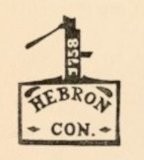
The Hebron Historical Society
Hebron, Connecticut
Enjoy Hebron - It's Here To Stay ™



Courtesy of Hebron Bicentennial booklet “Hebron, CT.”
In the 19th century, ministers began to think of themselves as professionals with careers. This change meant that in order to advance in their field, they and their families moved often. At the same time, church societies realized ministers might be lured to their towns if fashionable housing could be provided as part of the minister’s salary. The Parsonage was built in 1828 by John Graves for the
First Congregational Society. The use of the Parsonage would be considered part of the minister’s salary, but this put a heavy burden on the minister’s wife. She was expected to be part of various volunteer groups like the maternal society, temperance society, or abolition society. Thus, the parsonage became the social hub of the Town Green and the front parlor was the social gathering space. Carpenter John Graves took particular care to construct the fireplace surround in the minister’s front parlor. This advertised the minister family’s “good taste” as well as John Graves’ skills as a housewright. The woodwork from over the front parlor fireplace is now used as a sign for this building. Notice the extra amount of craftsmanship that the carpenter -builder John Graves used to give the front parlor an elegant feeling.
Think about it
How might your life be different if you were the local minister’s son or daughter?
Why might John Graves want to make the minister’s front parlor so fancy?
Finding clues to the past- Look at the photograph of #16 Main Street when Mr. Richard Gale, retired Principal of Hebron Elementary School, lived there. This building has been recently renovated or updated. What things have remained the same? What things are different?
Where to go next
From here continue to walk toward Route 85
Meet Your Neighbors QR Tours funded by the Hebron Greater Together Community Fund in conjunction with the Hebron Historical Society